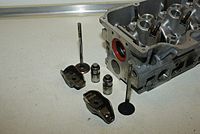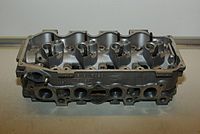
The Ford Kent is an internal combustion engine from Ford of Europe. Originally developed in 1959 for the Ford Anglia, it is an in-line four-cylinder overhead-valve–type pushrod engine with a cast-iron cylinder head and block.

The Ford small-block is a series of 90° overhead valve small-block V8 automobile engines manufactured by the Ford Motor Company from July 1961 to December 2000.

The Ford Pinto engine was the unofficial name for a four-cylinder internal combustion engine built by Ford Europe. In Ford sales literature, it was referred to as the EAO or OHC engine and because it was designed to the metric system, it was sometimes called the "metric engine". The internal Ford codename for the unit was the T88-series engine. European Ford service literature refers to it as the Taunus In-Line engine. In North America it was known as the Lima In-Line (LL), or simply the Lima engine due to its being manufactured at Lima Engine in Lima, Ohio.

The General Motors 60° V6 engine family is a series of 60° V6 engines produced for both longitudinal and transverse applications. All of these engines are 12-valve cam-in-block or overhead valve engines, except for the LQ1 which uses 24 valves driven by dual overhead cams. These engines vary in displacement between 2.8 and 3.4 litres and have a cast-iron block and either cast-iron or aluminum heads. Production of these engines began in 1980 and ended in 2005 in the U.S., with production continued in China until 2010. This engine family was the basis for the GM High Value engine family. These engines have also been referred to as the X engines as they were first used in the X-body cars.

The Ford Essex V6 engine is a 60° V6 engine built between 1966 and 1988 by the Ford Motor Company in the United Kingdom and until 2000 in South Africa although mostly in the Ford engine plant of Dagenham, Essex, which gave the engine its name. It is closely related to the Ford Essex V4 engine produced in displacements of 1.7 L and 2.0 L. Both engines share many parts since the Essex V6 was directly derived from the Essex V4; the 2.0 L Essex V4 and the 3.0 L Essex V6 in fact have exactly the same bore and stroke and share various components. In the same era, the Ford Cologne V6 engine was produced.

The Ford Cologne V6 is a series of 60° cast iron block V6 engines produced by the Ford Motor Company from 1962 to 2011 in displacements between 1.8 L; 110.6 cu in (1,812 cc) and 4.0 L; 244.6 cu in (4,009 cc). Originally, the Cologne V6 was installed in vehicles intended for Germany and Continental Europe, while the unrelated British Essex V6 was used in cars for the British market. Later, the Cologne V6 largely replaced the Essex V6 for British-market vehicles. These engines were also used in the United States, especially in compact trucks.

The Ford HSC engine is an automobile gasoline engine from the Ford Motor Company, sold from 1984 until 1994. HSC stands for High Swirl Combustion. It was made in two displacements: 2.3 L and 2.5 L, and used in only two model lines: the Ford Tempo/Mercury Topaz and the Ford Taurus/Mercury Sable.

The CA engine is a series of 1.6 to 2.0 L Inline-4 piston engines from Nissan. It is designed for a wide variety of smaller Nissan vehicles to replace the Z engine and some smaller, four-cylinder L series engines. The "CA" stands for Clean Air, due to the installation of Nissan emission reducing technology, called NAPS-X.
The Ford Motor Company produced straight-six engines from 1906 until 1908 and from 1941 until 2016. In 1906, the first Ford straight-six was introduced in the Model K. The next was introduced in the 1941 Ford. Ford continued producing straight-six engines for use in its North American vehicles until 1996, when they were discontinued in favor of more compact V6 designs.
The Ford Endura-D engine is a 1.8 L (1,753 cc) inline-4 Diesel engine used in a variety of vehicles made by the Ford Motor Company, including the Ford Escort (Europe), Ford Focus, Ford Fiesta, Ford Mondeo, Ford Orion, Ford Sierra, Ford Transit Connect and Ford Ikon.
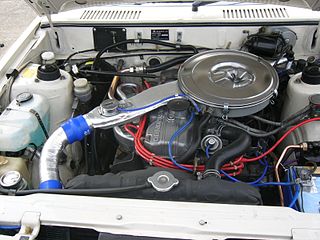
The Mitsubishi Astron or 4G5/4D5 engine, is a series of straight-four internal combustion engines first built by Mitsubishi Motors in 1972. Engine displacement ranged from 1.8 to 2.6 litres, making it one of the largest four-cylinder engines of its time.
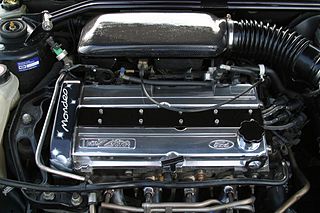
Developed in the late 1980s by the Ford Motor Company, the Ford Zeta engine was a straight-4, double overhead cam internal combustion engine with which Ford had intended to replace the analogous Pinto and CVH models.

The Ford Sigma is a small straight-4 automobile engine introduced in 1995 by Ford Motor Company. Its first evolution was sold as the Zetec-S, then Zetec-SE and finally, in later years, renamed Duratec. The last upgrade of the engine is named Duratec Ti-VCT. Conceived for Ford's smaller models, the motor was intended to replace the older HCS and smaller capacity CVH units.

The Ford EXP is a sports compact coupe that was produced by Ford Motor Company from 1982 to 1988. The first two-seat Ford since the original Ford Thunderbird, the EXP was derived from the American Ford Escort. In contrast to its platform counterpart, the model line was not a "world car", developed entirely for North America. For 1982 and 1983, the EXP was also sold as the Mercury LN7.

The Ford Escort is a small family car that was manufactured by Ford of Europe from 1968 until 2000. In total there were six generations, spread across three basic platforms: the original, rear-wheel-drive Mk.1/Mk.2 (1968–1980), the "Erika" front-wheel-drive Mk.3/Mk.4 (1980–1992), and the final CE-14 Mk.5/Mk.6 (1990–2002) version. Its successor, the Ford Focus, was released in 1998, but the final generation of Escort was phased out gradually, with the panel van version ending production in 2002 in favour of the Ford Transit Connect.
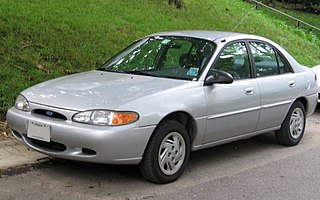
The North American version of the Ford Escort is a range of cars that was sold by Ford from the 1981 to 2003 model years. The direct successor of the Ford Pinto, the Escort also largely overtook the role of the European-imported Ford Fiesta as the smallest vehicle in the Ford model line in North America. Produced across three generations, the first generation was a subcompact; the latter two generations were compact cars. Becoming highly successful in the marketplace, the Escort became the best-selling car in the United States after 1982, a position it would hold for much of the 1980s.

F Renault engine is an automotive internal combustion engine, four-stroke, inline-four engine bored directly into the iron block, water cooled, with overhead camshaft driven by a timing belt, and with an aluminum cylinder head, developed and produced by Renault in the early '80s, making its appearance on the Renault 9 and 11. This engine is available in petrol and diesel versions, with 8 or 16 valves.
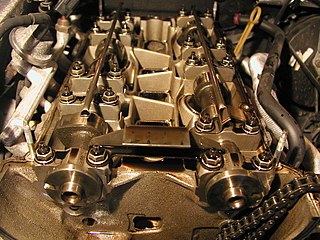
The Ford I4 DOHC engine is a cast iron block 4-cylinder inline internal combustion engine with twin overhead camshafts, produced by the Ford Motor Company at Dagenham Engine Plant. It was initially available as a 2.0 litre 8-valve version, and later in 2.0 and 2.3 litre 16-valve versions from 1989 to the end of production of the MK2 Ford Galaxy in 2006. It powered various Ford models during this time, but was most well known in the rear-wheel drive "Twin Cam" variants of the Ford Sierra and Ford Scorpio. Despite being built for the company's larger RWD models, Ford also employed the engine in the front-wheel drive Galaxy and the Escort RS 2000 16v.

Ford Motor Company used the Zetec name on a variety of inline 4-cylinder automobile engines. It was coined to replace "Zeta" on a range of 1.6 L to 2.0 L multi-valve engines introduced in 1991 because Ford was threatened with legal action by Lancia who owned the Zeta trademark. The company used the name widely in European advertising and later introduced it to the North American market with the Contour.

